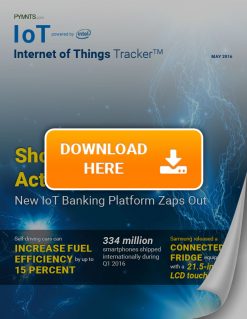Bringing ‘Shock’ Value To IoT-Powered Banking

The holy grail is making payments invisible – right? Maybe not so much for consumers trying to maintain budgets. PYMNTS’ May Internet of Things Tracker features an interview with David Webber, Managing Director Intelligent Environments, about how the company is using IoT to help power some, shall we say, “shocking” and buzzworthy technologies to keep consumers from going astray. The Tracker also includes a player directory of 71 companies, featuring 10 new additions.
As user-friendly digital and card-based payment solutions continue to replace physical currency, it’s clear that cash is no longer king in today’s financial ecosystem. But along with convenience, abstract capital also brings with it an increased risk for overspending. Digital financial solutions company Intelligent Environments is looking to empower budget-conscious consumers through what they’re touting as the first IoT banking platform, Interact IoT. The twist is rather shocking. Potential users will receive electric shocks to help them break bad habits and curb spending.
Meanwhile, IoT’s influence was felt far beyond banking this month, as numerous industries harnessed the power of interconnected technology in a spectrum of ways.
A number of automotive and tech players, including Google, Volvo, Ford, Uber and Lyft, formed the Self-Driving Coalition for Safer Streets with the goal of getting autonomous vehicles on the market as soon as possible. The group plans to work with private businesses and government agencies to expand studies about the safety benefits of self-driving cars. Researchers at Carnegie Mellon’s Human-Computer Interaction Institute introduced SkinTrack, a ring-powered IoT-based solution that lets users transform their lower arms into touchpads. While many wearables are clunky but only provide very small screens, this device is the opposite. It offers an extremely discreet physical component but projects a touchscreen that fits the user’s entire forearm. Although perhaps best known for its devices, tech giant Samsung recently got into the software side of the IoT game. The company developed a data exchange platform, ARTIK Cloud, that supports IoT connectivity.
Creating a buzz around budget management
May’s Tracker cover story features an interview with David Webber, Managing Director at U.K.-based Intelligent Environments, the company behind Interact IoT, what they are calling the world’s first IoT banking platform. Webber spoke to PYMNTS about the platform, as well as its initial integration with the Pavlok wristband, a wearable device that integrates with Interact IoT to send electric shocks to users who overspend.
Here’s a sneak peek:
As part of their IoT banking platform initial rollout, Intelligent Environments integrated the Pavlok wristband, a wearable interconnected device that “delivers an electric shock” to users’ wrists when they exceed predetermined spending, for example. So a user who sets a limit of $1,000, for example, will receive shock if they spend more than this amount.
The shock is in fact an electric shock – not just a splashier synonym for buzz or vibrate. The customizable technology enables wearers to create their own financial plans via a mobile app, in which they can also set the intensity of their physical alert: a vibration, buzz or shock ranging on a scale from one-to-10.
The concept of using wearable technology to eradicate bad habits is nothing new (think anti-snoring devices that claim to wake noisy sleepers and fitness bracelets that encourage users to keep active and lose weight). Pavlok’s connection to the IoT banking platform, however, makes it part of a wider push toward comprehensive cross-platform integration.
To download the Tracker, click the button below:
About the Tracker
The PYMNTS.com® Internet of Things Tracker, sponsored by Intel®, showcases companies that are leading the way in all aspects of the Internet of Things. Every month, the Tracker looks at what these companies are doing across the ecosystem and in six categories: Devices; Infrastructure; Payments; Security; Software; and Data

